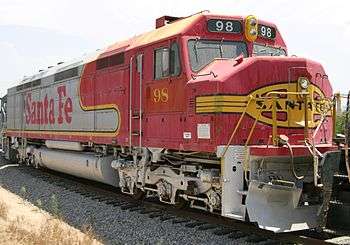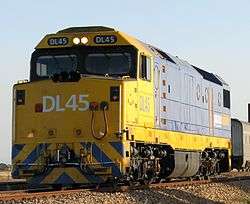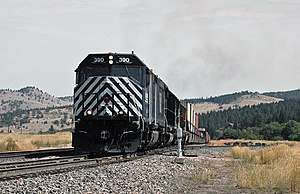Cowl unit
A cowl unit is a body style of diesel locomotive. The terminology is a North American one, though similar locomotives exist elsewhere. A cowl unit is one with full-width enclosing bodywork, similar to the cab unit style of earlier locomotives, but unlike the cab unit style, the bodywork is merely a casing and is not load-bearing. All the strength is in the locomotive's frame, beneath the floor, rather than the bridge-truss load-bearing carbody of the earlier type.

Cowl units were originally produced at the request of the Santa Fe, had a full-width 'cowl' body built on a hood unit frame which provided all the structural strength; the bodywork was cosmetic, rather than a load-bearing bridge truss frame as in cab units.
Most cowl units have been passenger-hauling locomotives. In this service, the cowl unit's full width bodywork and sleek sides match the passenger cars, do not allow unwanted riders, and allow the decorative, advertising paintwork desired by passenger operators. An additional benefit is that the locomotive can be more easily cleaned by going through the passenger-car washers. The cowl unit allows the basic structure of the locomotive to be identical to a freight-oriented hood unit type.
The main disadvantage of the cowl unit is low rear visibility from the cab of the locomotive. The EMD SD50F and SD60F, GE C40-8M and BBD HR-616 were given a Draper Taper (named after its creator, William L. Draper, a former Canadian National assistant chief of motive power) where the body is narrower immediately behind the cab, and gradually widens further aft, although the roof remains full-width the length of the locomotive. This improves rear visibility somewhat, but the locomotives still cannot lead a train in reverse as a hood unit can.
Passenger-oriented cowl units

- EMD FP45
- EMD SDP40F
- EMD F40C
- EMD F40PH
- EMD F40PHR
- EMD F40PH-2
- EMD F40PH-2CAT (rebuild)
- EMD F40PH-2M
- EMD GP40FH-2 (MK/MPI rebuild)
- EMD F59PH
- EMD F59PHI
- EMD F69PHAC
- EMD DE30AC
- EMD DM30AC
- EMD F125
- GE U30CG
- GE P30CH
- GE P40DC
- GE P32AC-DM
- GE P42DC
- MPI F40PHL-2
- MPI F40PH-2C
- MPI F40PH-3C
- MPI MP36PH-3C
- MPI MP36PH-3S
- Siemens Charger
Export/license-built cowl units

- EMD AT42C
- EMD FT36HCW-2
- GE UM12C (Philippine service)[1]
LMS 10000 & 10001
The LMS Diesels 10000 & 10001, later classified as British Rail Class D16/1, were introduced in 1947. These were Great Britain's first mainline diesel locomotives, coming about a decade after America's first cab units. Despite their streamlined exterior, they are actually cowl units rather than cab units. It is easy to misinterpret this as in North America, cowl designs are more angular, while cab designs have a similar curved streamlining.
References
- Pinkepank, Jerry A., and Marre, Louis A. (1979). Diesel Spotter’s Guide Update, pp. 70–79. Kalmbach Publishing Co. ISBN 0-89024-029-9.
- "1956 0421 MRR Roadswitchers". Retrieved February 15, 2020.
